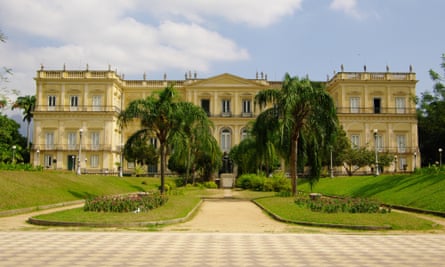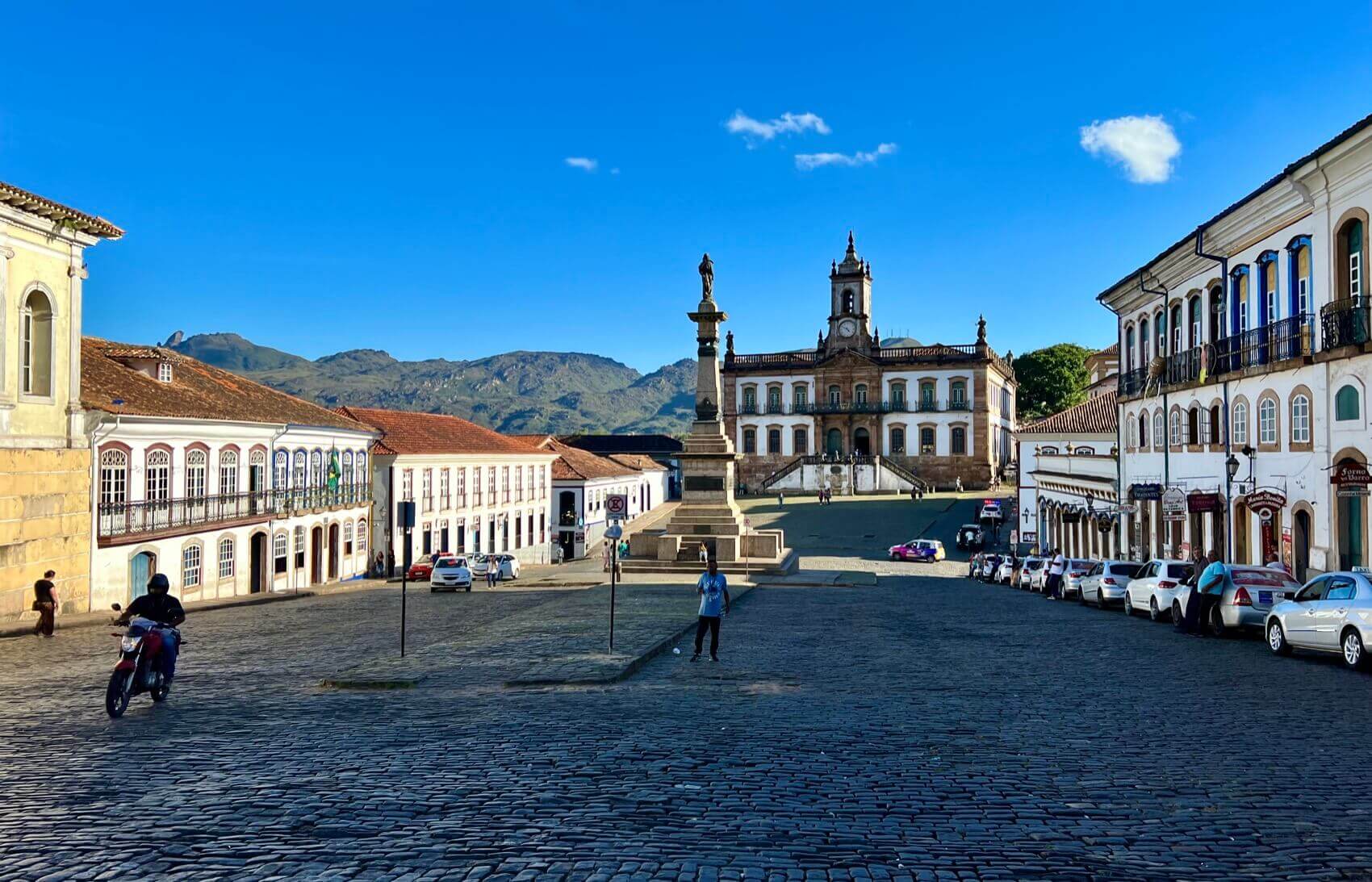
Museu Nacional in Rio de Janeiro
Museu Nacional: History and significance
Nestled in the heart of Rio de Janeiro, Museu Nacional holds a rich history that traces back to the early 19th century. Originally established as a Royal Museum by Dom João VI in 1818, it became a focal point for scientific and cultural advancements in Brazil. The museum’s impressive historical significance is deeply rooted in its role as the country’s first natural history museum and its connection to the Portuguese royal family.
Collections and exhibitions at Museu Nacional
Natural History Collection: – The museum boasts an extensive collection of over 20 million items, ranging from fossils and minerals to botanical specimens and archaeological artifacts. – Visitors can marvel at the diverse flora and fauna of Brazil showcased through dioramas and interactive exhibits. Egyptian Artifacts: – One of the standout features of Museu Nacional is its rare collection of Egyptian artifacts, including mummies, statues, and hieroglyphics. – These treasures offer a glimpse into the ancient civilization’s customs, artistry, and religious beliefs. Brazilian Anthropology: – The museum houses a comprehensive collection of indigenous Brazilian artifacts, providing insights into the country’s rich cultural heritage. – Visitors can explore traditional crafts, tools, and ceremonial objects that highlight the diversity of Brazil’s indigenous communities. Exhibitions: – Museu Nacional regularly hosts temporary exhibitions that delve into various themes, from contemporary art to historical retrospectives. – These dynamic displays engage visitors with thought-provoking narratives and artistic expressions that reflect Brazil’s vibrant cultural tapestry. As you immerse yourself in the halls of Museu Nacional, you not only witness the beauty of its collections but also experience a profound connection to Brazil’s past, present, and future. It stands as a beacon of knowledge and preservation, inviting visitors to explore the wonders of natural history and cultural heritage in a captivating setting.

Museu de Arte Sacra de São Paulo
Museu de Arte Sacra: Religious art and artifacts
Steeped in spirituality and artistic excellence, Museu de Arte Sacra de São Paulo stands as a beacon of religious heritage and devotion. Founded in 1969, the museum is dedicated to preserving and showcasing a remarkable collection of religious art and artifacts that reflect Brazil’s deep-rooted cultural and religious traditions. Here, visitors have the opportunity to explore centuries-old masterpieces that offer a glimpse into the intersection of faith and creativity. Baroque Masterpieces: – The museum’s collection features exquisite examples of Baroque religious art, characterized by its ornate details, rich symbolism, and dramatic expressions of faith. – Visitors can admire intricately carved wooden sculptures, gleaming gold-leaf altarpieces, and vibrant paintings that narrate biblical stories with fervor. Liturgical Objects: – Museu de Arte Sacra houses a diverse array of liturgical objects used in Catholic religious ceremonies, including chalices, reliquaries, and ornate vestments. – These sacred artifacts not only showcase the craftsmanship of artisans but also serve as tangible links to Brazil’s religious history and traditions. Colonial Religious Art: – The museum’s collection includes a significant number of colonial-era religious artworks that embody the fusion of European and indigenous artistic influences. – Visitors can explore how these pieces convey the complexities of cultural exchange and spiritual syncretism in Brazil’s colonial past.
Special exhibitions and events at Museu de Arte Sacra
Interdisciplinary Dialogues: – Museu de Arte Sacra hosts special exhibitions that foster interdisciplinary dialogues between art, religion, and culture. – These thematic displays explore contemporary interpretations of religious art and engage visitors in thought-provoking conversations about faith and artistic expression. Educational Programs: – The museum organizes a variety of educational programs, workshops, and guided tours that offer deeper insights into the history and significance of religious art. – Visitors can participate in lectures, demonstrations, and hands-on activities that enrich their understanding of Brazil’s diverse religious traditions. As you explore Museu de Arte Sacra de São Paulo, you embark on a captivating journey through the spiritual and artistic treasures that illuminate the profound connections between faith, art, and culture. It is a sanctuary where history…

Museu Imperial in Petrópolis
Museu Imperial: Former palace turned museum
Set in the picturesque city of Petrópolis, Museu Imperial stands as a testament to Brazil’s imperial past, offering visitors a glimpse into the opulent lifestyle of the country’s monarchs. Originally built as a summer residence for Dom Pedro II in the 19th century, the palace was transformed into a museum in 1943, preserving its architectural splendor and historical significance. Today, Museu Imperial invites guests to step back in time and immerse themselves in the grandeur of Brazilian royalty. Architectural Marvel: – The museum’s magnificent architecture reflects the neoclassical style favored by the Brazilian imperial family, featuring elegant facades, ornate interiors, and lush gardens. – Visitors can wander through opulent ballrooms, elaborate salons, and royal chambers that transport them to a bygone era of pomp and grandeur. Historic Transformation: – Museu Imperial’s evolution from a royal residence to a cultural institution symbolizes Brazil’s transition from monarchy to republic, capturing the shifting tides of history and governance. – The museum’s restoration efforts have preserved not only the physical structure but also the stories and legacies of Brazil’s imperial era.
Imperial collections and historical significance at Museu Imperial
Imperial Treasures: – The museum’s collections showcase a wealth of imperial artifacts, including furniture, paintings, silverware, and personal belongings of the royal family. – Visitors can admire rare period pieces that offer insights into the lavish lifestyles, exquisite tastes, and cultural influences of Brazil’s imperial rulers. Historical Narratives: – Museu Imperial presents a compelling narrative of Brazil’s monarchy through exhibitions that highlight key moments, figures, and events in imperial history. – Through interactive displays, multimedia presentations, and archival materials, visitors can explore the complexities and nuances of Brazil’s imperial legacy. As you wander through the halls of Museu Imperial in Petrópolis, you are not just a spectator but a time traveler, experiencing the grandeur, intrigue, and legacy of Brazil’s imperial past firsthand. The museum’s…
Memorial da Resistência in São Paulo
Memorial da Resistência: Focus on human rights and resistance
Nestled in the vibrant city of São Paulo, Memorial da Resistência serves as a poignant reminder of Brazil’s tumultuous history of political repression and societal injustices. The museum’s primary focus lies in honoring the brave individuals who stood up against authoritarian regimes, fought for human rights, and championed the cause of resistance. By shedding light on past struggles and advocating for social justice, Memorial da Resistência stands as a beacon of hope and solidarity for all. Pillar of Resistance: – The museum serves as a symbolic pillar of resistance, commemorating the sacrifices and struggles of activists, dissidents, and ordinary citizens who resisted oppression and defended democratic values. – Visitors are invited to reflect on the universal principles of freedom, equality, and justice that underpin the ongoing fight for human rights around the world. Interactive Exhibits: – Memorial da Resistência features thought-provoking exhibits that showcase historical artifacts, personal testimonies, and multimedia presentations highlighting pivotal moments in Brazil’s history of resistance. – Through immersive experiences and engaging narratives, visitors are encouraged to confront difficult truths, challenge prevailing narratives, and participate in dialogues on activism and social change.
Exhibits and educational programs at Memorial da Resistência
Documenting Injustice: – The museum’s exhibits document instances of political repression, state violence, and human rights abuses that have shaped Brazil’s recent history. – By shedding light on past atrocities and injustices, Memorial da Resistência seeks to foster a culture of remembrance, accountability, and advocacy for human rights. Educational Initiatives: – Memorial da Resistência offers a range of educational programs, workshops, and seminars that engage visitors of all ages in conversations about democracy, citizenship, and social activism. – Through collaborative partnerships with schools, community organizations, and human rights advocates, the museum plays a vital role in promoting civic engagement and critical thinking. As you navigate the halls of Memorial da Resistência in São Paulo, you are not just a visitor but a participant in a living tribute to the resilience, courage, and unwavering spirit of those who have fought for justice and human dignity. The museum’s…

Museu da Inconfidência in Ouro Preto
Museu da Inconfidência: Celebrating Brazil’s independence movement
Located in the historic town of Ouro Preto, Museu da Inconfidência stands as a living tribute to Brazil’s fervent quest for independence and freedom. The museum is dedicated to celebrating the brave souls who participated in the Inconfidência Mineira, a revolutionary movement that sought to overthrow Portuguese colonial rule in the late 18th century. By honoring their courage, ideals, and sacrifices, Museu da Inconfidência preserves the spirit of Brazil’s independence movement for generations to come. Revolutionary Spirit: – The museum reverberates with the revolutionary spirit of the Inconfidência Mineira, showcasing artifacts, documents, and artworks that illuminate the aspirations and struggles of the movement’s leaders and supporters. – Visitors are invited to delve into the tumultuous era of colonial Brazil and witness the resilience and resilience of those who dared to dream of a liberated nation. Symbol of Freedom: – Museu da Inconfidência serves as a symbol of freedom and national pride, paying homage to the heroes of the independence movement who risked everything for the dream of a free and sovereign Brazil. – Through exhibitions, events, and educational initiatives, the museum nurtures a sense of patriotism and historical consciousness among visitors of all backgrounds.
Artifacts and historical narratives at Museu da Inconfidência
Historical Artifacts: – The museum’s collection features a diverse array of historical artifacts related to the Inconfidência Mineira, including personal belongings of key figures, revolutionary pamphlets, and political manifestos. – Visitors can immerse themselves in the material culture of the independence movement, gaining insights into the daily lives, beliefs, and struggles of those who fought for Brazil’s freedom. Narratives of Liberation: – Museu da Inconfidência weaves together compelling narratives that chronicle the events leading up to the failed revolt, the trials of the conspirators, and the enduring legacy of the independence movement. – Through multimedia presentations, interactive displays, and guided tours, visitors are guided through a profound journey of discovery and reflection on Brazil’s tumultuous path to nationhood. As you explore Museu da Inconfidência in Ouro Preto, you embark on a transformative voyage through Brazil’s tumultuous past, where the echoes of rebellion, resilience, and liberation resonate with…

Conclusion
Overview of the top historical museums in Brazil
As you traverse the diverse cultural landscape of Brazil, the country’s historical museums emerge as compelling gateways to the past, offering immersive experiences that illuminate the rich tapestry of Brazilian history and heritage. From the grandeur of Museu Imperial in Petrópolis to the poignant narratives of Museu da Inconfidência in Ouro Preto, each museum weaves a unique story of struggle, resilience, and transformation that resonates with visitors from around the world. Top Historical Museums: 1. Museu Nacional in Rio de Janeiro: Showcasing Brazil’s natural and cultural heritage 2. Museu de Arte Sacra de São Paulo: Celebrating religious art and traditions 3. Museu Imperial in Petrópolis: Preserving Brazil’s imperial legacy 4. Memorial da Resistência in São Paulo: Honoring human rights and activism 5. Museu da Inconfidência in Ouro Preto: Commemorating Brazil’s independence movement
Importance of preserving and visiting historical museums
Historical museums serve as vital custodians of a nation’s collective memory, safeguarding its treasures and stories for future generations. By preserving tangible artifacts, narratives, and cultural traditions, these institutions play a crucial role in fostering historical consciousness, promoting cultural identity, and nurturing a sense of civic pride among visitors. Significance of Preservation: – Historical museums preserve tangible and intangible heritage, safeguarding artifacts and narratives that reflect the complexities and richness of a nation’s past. – Through meticulous curation, conservation efforts, and educational programs, museums ensure that history remains accessible, relevant, and engaging for present and future audiences. Educational Value: – Visiting historical museums offers immersive learning experiences that go beyond textbooks and classroom teachings, allowing visitors to engage with history firsthand through interactive exhibits, guided tours, and educational programs. – By engaging with diverse perspectives, challenging assumptions, and sparking critical thinking, museums encourage visitors to develop a deeper understanding of the past and its impact on the present. As we navigate the corridors of Brazil’s historical museums, we not only uncover the layers of the past but also acknowledge the enduring importance of preserving and cherishing our cultural heritage. These museums stand as beacons of knowledge, inspiration, and reflection, inviting us to connect with the stories and struggles that have shaped Brazil’s remarkable journey through time.
